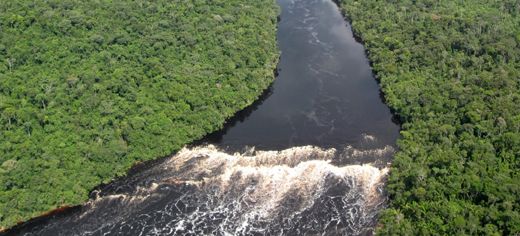
Academics from the University of Leeds have joined researchers from around the world to generate the first basin-wide estimates of the abundance and distribution of trees in the Amazon rainforest.
The research, which was published in Science, suggests that half of the estimated 390 billion trees in Greater Amazonia, which spans nine countries, belong to only a tiny fraction of the different species found there. The findings could aid conservation efforts and climate change research the future.
Professor Oliver Phillips, Royal Society Wolfson Researcher in the School of Geography at the University of Leeds and study co-author, said:
“For the first time, plant ecologists have managed to work out which species dominate Greater Amazonia. This has required a huge collaborative effort, with more than 100 researchers working in each one of the nine nations of Amazonia.”
Historically, the vast extent and difficult terrain of Greater Amazonia – which includes the Amazon Basin (spanning Brazil, Ecuador, Bolivia, Peru, Columbia, and Venezuela) and Guiana Shield (Guiana, Suriname, and French Guiana) – had restricted the study of its extraordinarily diverse tree communities to local and regional scales.
“In essence, this means that the largest pool of tropical carbon on Earth has been a black box for ecologists, and conservationists don't know which Amazonian tree species face the most severe threats of extinction,” said Dr Nigel Pitman, who is the Robert O. Bass Visiting Scientist at The Field Museum in Chicago and a co-author of the study.
However, in the new study, researchers combined data from 1,170 forestry surveys to finally answer two long-standing questions: How many trees are there in Greater Amazonia, and how many tree species occur there?
Extrapolations from this large sample suggest that Greater Amazonia harbours about 390 billion individual trees, belonging to some 16,000 species. But half of all the trees in the region belong to just 227 of those species, say the researchers. The authors termed these species ‘hyperdominants’.
“That's a much smaller number than anyone anticipated, and it really helps simplify our work,” said Dr Hans ter Steege, first author on the study and a researcher at the Naturalis Biodiversity Center in Leiden, the Netherlands.
While the study suggests that hyperdominants – just 1.4% of all Amazonian tree species – account for roughly half of all carbon and ecosystem services in Greater Amazonia, it also notes that almost none of them are consistently common across the region. Instead, most hyperdominants are found in a particular region or forest type, such as swamps or upland forests.
The study also offers insights into the rarest tree species in Greater Amazonia. According to the mathematical model used in the study, roughly 6,000 tree species in Greater Amazonia have populations of fewer than 1,000 individuals, which automatically would qualify them for inclusion in the International Union for Conservation of Nature (IUCN) Red List of Threatened Species.
Yet, as their environment changes, some of the rarest species may thrive in the future. “The Amazon is changing fast now, and is becoming hotter than ever before in human history. So, if we can conserve enough of the forest, among these thousands of very rare species could be the winners – the ‘hyperdominants’ – of the future,” concluded Professor Phillips.
The principle contributors to the Amazonian work by Professor Phillips and his University of Leeds colleagues during the past ten years were the Natural Environment Research Council, the European Research Council, the Gordon and Betty Moore Foundation, The Leverhulme Trust and The Royal Society.
Further information
The study, "Hyperdominance in the Amazonian Tree Flora", is published online by the journal Science.
Professor Oliver Phillips is available for interview. To arrange, please contact Gareth Dant, Press Officer, University of Leeds, on +44 (0)113 343 3996 or email g.j.dant@leeds.ac.uk